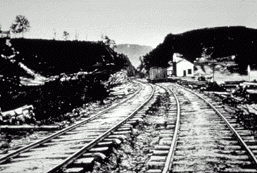
Godfrey Barnsley at Woodlands
Godfrey Barnsley came from Savannah to Bartow County (Cass County…
One of the first things people notice about Downtown Cartersville is the number of trains that go through every day.
In fact, about two per hour – 50 per day – bisect downtown. There are two bridges over the tracks and still some complain. But kids love them, and everybody jokes about them. Once, a jokester at the Convention & Visitors Bureau suggested ” A Train Runs Through It,” as a theme line for the City.
Anyway, the reason for dwelling on trains is that it’s very appropriate that traffic stops for them 50 times daily. That’s because most of the traffic stops in front of Friendship Plaza, Cartersville’s downtown park, and the plaza is named in honor of the man responsible for bringing trains here in the first place more than 150 years ago. The man was Mark Anthony Cooper.
Now the reason it’s Friendship Plaza instead of “Cooper Plaza” is that the name is taken from a unique monument Cooper commissioned which stands in the park. It’s called “The Friendship Monument.” Cooper commissioned the monument in 1857 to honor 38 friends who had aided him in a financial crisis, and it’s believed to be the only monument in existence erected by a debtor to honor his creditors. And what got Cooper into financial trouble to start with? Well, trains of course. Here’s the story:
In 1831 Mark Cooper and a friend, Charles P. Gordon, called the first convention to publicly consider building a railroad in Georgia. Cooper and Gordon were from Eatonton, Georgia and both were elected to the Georgia Legislature in 1833 where they continued their efforts. As a result, the state owned Western & Atlantic (W&A) Railroad was completed in 1850 connecting Atlanta and Chattanooga.
Cooper had moved here in the early 1840’s and established a thriving iron production and manufacturing enterprise just south of Cartersville at the town of Etowah called the Etowah Iron and Manufacturing Company. But the iron and other goods produced at Etowah were about two miles from the newly completed W&A Railroad. So in 1847 the Etowah Railroad Company was incorporated to transport the goods to the main railroad. Cooper’s business partner couldn’t pay his share of the tracks and Cooper bought him out. In 1857 Cooper was $100,000 in debt and the Etowah Iron and Manufacturing Company was auctioned. Cooper bought the company back with a $200,000 note to be paid in three years. The 38 friends whose names appear on the Friendship Monument today endorsed the note. By 1859 Cooper paid off note and in 1860 paid tribute to his friends with the erection of the Friendship Monument on the Etowah Town Square.
Along came the Civil War, and Etowah gained prominence as a manufacturing center for the Confederacy. Eventually the Confederate Government bought and operated the iron works. A major target of the Atlanta Campaign, in May, 1864 troops under General William T. Sherman
[US] destroyed everything there except the Friendship Monument. It stood a silent sentinel to a lost cause for sixty-seven years. Then a movement began to dam the Etowah River and build a lake for flood control. The town that was Etowah would be flooded by Lake Allatoona. In 1927 the Friendship Monument was moved to downtown Cartersville to escape. Cartersville hosted a grand ceremony, and the Friendship Monument was unveiled by Mark A. Cooper’s great-great grandson Mark Cooper Pope, then three years old. By the 1960’s the town of Cartersville decided it needed more parking spaces and no longer wanted the monument. The Corps of Engineers said they had a lovely place for it on a knoll overlooking Lake Allatoona where Cooper’s Etowah used to be. So the monument was moved again.
In the mid-1990s people started talking about moving the monument back to Cartersville and the talk spread to Atlanta where Mark Cooper Pope lives. Pope wanted the monument back in Cartersville, too, and generously lent resources to make it possible. In 1999, in conjunction with the Cartersville Sesquicentennial Celebration, the Cartersville City council approved moving the Friendship Monument back downtown and named the square where the monument would be placed “Friendship Plaza.”
But Friendship Plaza is more than a tribute to Mark Cooper. In addition, visitors will notice plaques on the fence next to the railroad that are Cartersville’s tribute to her other notable citizens. They include:
So, should you find yourself sitting in downtown Cartersville waiting for the train to go by, don’t fret. Pull into a parking place, stroll around Friendship Plaza, and acquaint yourself with some of our notable sons and daughters. Then, you might want to cross the street and photograph the World’s First Coca-Cola Wall Sign on the side of Young Brother’s Pharmacy – and pick up a Coke while you’re there. Also stop in at the Cartersville Welcome Center in the 1854 depot operated by the Cartersville Downtown Development Authority.

Godfrey Barnsley at Woodlands
Godfrey Barnsley came from Savannah to Bartow County (Cass County…

General Sherman & Cecelia Shelman
The Softer Side of General Sherman: A Story of Enduring…

General P.M.B. Young
Born: Spartanburg, South Carolina, November 15, 1836 Died: July 6…

U.S. Senator Rebecca Latimer Felton
U.S. Senator, teacher, publisher, author, columnist, political strategist and advisor…

Cass County to Bartow County
The earliest evidence of human occupation of the Bartow County…

Rev. Sam Jones
The most famous and celebrated evangelist of his time, Sam…
This site uses cookies to provide you with an optimized experience. Learn More